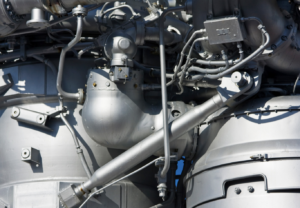Anúncios
An example of what the appearance of an air taxi would be like
In the event that a government statement is carried out according to plan, the first flying taxi might take off in the United Kingdom by the year 2026, and it could become a common sight in our skies two years later.
In addition, the action plan for the Future of Flight, which was established in collaboration with the aerospace sector, states that drones and other flying vehicles will become increasingly autonomous.
Anúncios
A pilotless flying taxi is expected to make its debut in the year 2030, according to this prediction.
However, according to the experts, there are obstacles that need to be conquered first, such as infrastructure and public approval.
Anúncios
There are a variety of types available, but the majority of flying taxis have the appearance of a future helicopter and have the capacity to transport around five passengers.
The term “eVTOLs” refers to a family of vehicles that are referred to as “electric vertical take-off and landing aircraft.” These vehicles are a member of this family.
Although the technology necessary for them is already available, it is quite probable that the aircraft will first be used as exclusive forms of transportation, taking the place of helicopters, which are now used for pricey excursions.
It is also planned by the Department of Transport to make it possible for drones to fly beyond the visual line of sight, which means that the person who controls the drone will not be able to see it while it is in the air.
Unmanned drones have a variety of applications, including the delivery of postal packages in remote regions, the transportation of medical supplies, and the tracking down of criminals who are on the run.
The strategy forecasts that drone deliveries would become widespread by the year 2027, despite the fact that their usage is still in its early phases
A.P. A huge drone with the insignia of the National Health Service and the flag of the United KingdomA.P.
When it comes to bringing flying taxis into the air, the most significant challenges, according to Craig Roberts, head of drones at the consulting company PwC, are infrastructure and public image. In 2022, the National Health Service (NHS) will deploy drones for delivery purposes.
During the course of the previous year, he collaborated with the government to produce a study on the subject, which was centred on the feasibility of the technology.
As for the aim for the year 2026, he adds, “It is challenging, but it is possible.“
Mr. Roberts is of the opinion that “longer distance, higher occupancy cases” are the most effective examples of how the technology might be used.
One example that is provided in the study by the government is a flight that takes 26 minutes to get from Liverpool to Leeds.
According to him, “It might start off as being more of a replacement for helicopters,” but there is a possibility that demand would gradually grow to the general people.
It would also be necessary to show the ease to a larger audience by using technology advancements in the screening process for sensitive information.
The PwC analysis makes the assumption that it takes ten minutes from the moment an individual arrives at a flying taxi rank to the time they take off. This is a task that is presently difficult to do, considering the amount of time it takes to pass through a traditional airport.
“The industry knows this is a problem and knows it has to be solved… But there are technological ways of doing this,” according to Mr. Roberts.
“What was holding this back for a long time was the barriers to certification of a new technology,” explains Dr. Nadjim Horri, a lecturer in aeronautical control at the University of Leicester. “This was taking a long time.”
However, he claims that this is beginning to change, as regulations are beginning to catch up with the technical advancements that have been made in the sector.
It is also necessary for the general people to have faith in the new technology in order for it to be adopted, but he says that the year 2026 is a reasonable target for the introduction of flying taxis into the air.
Where exactly would the cars come to a stop and leave?
New infrastructure projects in the United Kingdom, such as “mini airports” for drones, would be necessary in order to implement the suggestions.
on 2022, a proof of concept was carried out by establishing a miniature airport on a parking lot close to the core business district of Coventry.
The firm that is responsible for it, Urban Air Port, believes that the future of air taxis will exist as a supplement to existing means of transportation rather than as a substitute for them.
According to Andrea Wu, the company’s chief executive officer, transit hubs need to be located in metropolitan centers; yet, “there has not been enough investment in infrastructure” in the United Kingdom up to this point.
She refers to the hypothesis that flying taxis would become a common sight by the year 2028 as a “ambitious timeline” due to the fact that there will be a requirement to construct locations where they can take off and land.
In response to the news that was made on Monday, Ms. Wu said, “But the entire industry agrees that in order to move this forward, you need to put something down on paper.”
Subsequent to the demonstration that took place two years ago, no other tiny airports have been constructed or tested. However, the plan that the government has been working on indicates that the first vertiport, which is an airport for vertical vehicles, will be operating this year.
Proposals for vertiports at existing aerodromes are now being considered by the Civil Aviation Authority, which is the regulatory body for aerospace in the United Kingdom.
In order for the government to achieve its goal of introducing autonomous air taxis by the year 2030, it is virtually inevitable that new regulations will need to be developed.







